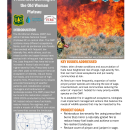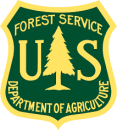Location



















States
UtahEcosystem
ForestIntroduction
Fishlake National Forest (Fishlake NF) in Central Utah is the home to 1.8 million acres of diverse forested ecosystems with varying fire regimes. The Old Woman Plateau (OWP) in the Fishlake NF contains shrublands, dry grasslands, ponderosa pine (Pinus ponderosa), mixed conifer and aspen (Populus tremuloides) forests. Pre-European settlement, many of these ecosystems, such as ponderosa pine (Pinus ponderosa) forests, burned frequently, with mostly low to moderate severity, while others, such as high elevation mixed conifer stands, burned infrequently with higher severity, stand-replacing fire.
A recent history of less frequent fire on the OWP has led to an increase in heavy fuels. These heavy fuels, paired with increased climate variability and longer periods of hotter, drier weather, can cause larger and more severe fires in both fire-adapted and non-fire-adapted ecosystems. Even before the recognition of the nationwide Wildfire Crisis, the Fishlake NF began incorporating fire action plans into restoration initiatives, including prescribed burn prescribed burn
A prescribed burn is the controlled use of fire to restore wildlife habitat, reduce wildfire risk, or achieve other habitat management goals. We have been using prescribed burn techniques to improve species habitat since the 1930s.
Learn more about prescribed burn plans. These fire action plans offer management strategies to get ahead of the effects of widespread wildfires and lessen the impacts on the ecosystem and the surrounding communities.
Prescribed burns are often used to reintroduce fire to an ecosystem of interest, reduce heavy fuel loads, and limit the size of high-severity fires. For prescribed burns to effectively meet stated goals and be implemented in an efficient and safe manner, there is a need for accurate forecasting of weather patterns and collaboration among managers and landowners at a landscape scale.
The Old Woman Plateau prescribed burns and restoration project of 2022 and 2023 conducted by the Fishlake NF Forest Service created an inclusive burn prescription across multiple land ownerships. This prescription was designed to reduce heavy fuel loads and restore historic fire regimes to 16,400 acres of land on the OWP using burn model strategies to create a mosaic of different burn severities, and sizes that mimic natural fire behavior and effects on the land. Additional restoration efforts included manual removal of ladder fuels using mechanical equipment before the burn, and wildlife habitat restoration post-burn.
Key Issues Addressed
Forests on the OWP are overcrowded and vulnerable to high-intensity, high-severity wildfires that do not match historical fire regimes. Hotter, drier climate conditions have further increased the intensity of wildfire and the severity of their impacts on vegetation and wildlife. For shrublands, mixed conifer and aspen forests, threats include larger and more frequent high-severity stand-replacing fires than they evolved with. This can leave potential for ecosystem conversion and loss of habitat for native species. In ponderosa pine forests, higher severity fire can cause higher mortality of mature trees. Increasing size of high-severity fire threatens private homes as well as public health.
Native pinyon-juniper expansion has increased in sage, mountainbrush, and oak communities. Pinyon and juniper are opportunistic woodland species and are some of the first to re-grow in the recently burned areas. Coupled with an increase in fire activity, pinyon-juniper growth has contributed to a shift in neighboring ecosystems away from sagebrush sagebrush
The western United States’ sagebrush country encompasses over 175 million acres of public and private lands. The sagebrush landscape provides many benefits to our rural economies and communities, and it serves as crucial habitat for a diversity of wildlife, including the iconic greater sage-grouse and over 350 other species.
Learn more about sagebrush -dominated communities and towards an expansion of pinyon-juniper stands.
The expansion of pinyon-juniper ecosystems and heightened fire susceptibility threaten the habitat of many wildlife species on the OWP. As the Fishlake NF and their partners work to re-establish the role of fire in the ecosystems they manage, biologists must implement management actions that balance the needs of wildlife species that may be affected by fire.
Project Goals
Burning for the Future: Proactive management strategies, such as prescribed burning, are becoming increasingly important to implement into land management activities to effectively get ahead of adverse ecosystem impacts from the Wildfire Crisis.
- Reintroduce low to moderate severity fire using prescribed burns in a mosaic burn model to achieve a more fire-resilient landscape. The series of prescribed burns will incorporate a mosaic of burnt and unburnt areas that mirror a naturally ignited fire to reduce heavy fuel loads and limit ecosystem impacts from high-severity wildfires.
- Reduce canopy cover of pinyon-juniper to less than 10% of the total canopy cover in sage, mountainbrush, and oak communities to create fuel breaks and limit spread of high-severity fire.
- Improve conditions of the Salina Creek watershed on the Old Woman Plateau in the Fishlake National Forest to benefit multiple wildlife species.
Project Highlights
- Thinning and Mastication to Prepare for Prescribed Burns: To minimize the possibility of prescribed burns growing beyond management capacity, personnel removed ladder fuels within designated areas on the OWP before burns. The Fishlake NF used hand tools, such as chainsaws, and mechanical tools, such as heavy machinery, to thin forested areas and masticate unwanted vegetation. As of 2023: 4,461 acres were thinned using hand tools, 966 acres were thinned or masticated with heavy equipment, and prescribed burns were conducted across 14,580 acres of land.
- Developing Ecosystem-Centric Burn Prescriptions: The Fishlake NF developed burn prescriptions focused on how the ecosystems naturally burn. For ponderosa pine stands, they developed low to moderate-severity burn plans that remove primarily fine fuels and litter. However, high-severity burn plans with intentional tree mortality to reduce heavy fuel loads were developed for aspen and mixed conifer stands. Additionally, a mosaic burn model was implemented in designated public and adjacent private lands when conducting prescription burns. This created patches of burnt and unburnt forest, allowing the fire to closely resemble natural fire behavior in the ecosystem.
- Reducing Fire Severity in Sagebrush by Treating Pinyon and Juniper: Removal crews prioritized areas with high pinyon-juniper canopy cover to reduce fuel continuity and control the species before burning the project area. By reducing pinyon-juniper canopy cover to less than 10% of the total canopy cover, Fishlake NF reduced the risk of high-severity fire in important sagebrush wildlife habitats. As of 2023, 5,427 acres of pinyon-juniper have been thinned or masticated.
- Improving Wildlife Conditions in the Watershed: Fishlake NF conducted prescribed burns throughout sagebrush and mountainbrush communities. Although fire may have short-term negative impacts on sagebrush communities, it can reduce canopy cover of pinyon-juniper species in the long-term. In this way, prescribed burns can help sagebrush communities resist the risk of ecosystem conversion to pinyon-juniper woodlands. Additionally, as of 2024, the Fishlake NF has installed four wildlife guzzlers for wildlife such as Rocky Mountain elk (Cervus canadensis), Mule deer (Odocoileus hemionus), moose (Alces alces) and other wildlife species to use as an added water resource, especially valuable during times of diminished water resources.
Lessons Learned
While this project was successful on the OWP there is a need for more frequent communication among agencies and with the public to increase the pace and scale of prescribed burning work. Scheduling prescribed fires months in advance can lead to delayed ignitions due to unfavorable conditions on the scheduled date. Increasing the frequency of conversations among agencies can help plans be more adaptable in the face of unpredictable conditions and reduce potential delays. Furthermore, lack of public awareness and understanding of prescribed fire can slow planned burns. To increase the scale and effectiveness of the project, the Fishlake NF worked with state and federal agencies to make sure that the public was properly informed about the prescribed burn. This was done through official notices by the Central Utah Interagency Fire Center (CUIF) and the USFS for the public that were distributed at information kiosks and on social media.
The Fishlake NF collaborated with adjacent large private landowners to increase the size and scale of the project area being treated and to develop an inclusive fire prescription and support within the community. The Fishlake NF planned for 12,339 acres of USFS land to be burned and provided nearby landowners, who each owned hundreds of acres of land, the option to include their land in the OWP prescription. This means landowners were able to include their property in the prescribed burn plan to mitigate fire risks to their homes and allow Fishlake NF and State personnel to burn their land. By collaborating with private landowners, an additional 3,988 acres of private land were included in the prescribed burns.
Fuels modeling is often used to understand how fire will behave in a landscape. To develop an effective prescription for a project area, it is important to understand how the fuels may burn to reduce the risk of the burn getting out of control. Warmer, drier climate trends have led to longer seasons of fire susceptibility and have heightened the need for careful modeling and incorporation of up-to-date climate and weather data. The Fishlake NF uses the Standard fire behavior fuels model that accounts for the spatial distribution of fuels and the vegetation composition within a project area. This information allows Fishlake NF managers to have a better understanding of the ecosystem and develop a prescribed burn plan based on the weather conditions and needs of the project area. Since the OWP is composed primarily of sage, mountainbrush, and oak communities that have evolved to burn at low to moderate severities, intensive monitoring of weather conditions during burn events was crucial for keeping the burn under control.
Next Steps
- Collaborate with nearby communities and private landowners to establish forest management practices that can reduce the risk to the public from extreme fire danger
- Continue focused improvement of wildlife habitat and improvements to the Salina Creek Watershed
- Establish annual treatments for 40,000 to 124,000 acres of the Fishlake National Forest using a combination of prescribed fire and forest thinning practices
Funding Partners
- World Resources Institute
- US Forest Service Fuels Program
- Utah Forestry, Fire, and State Lands Fuels Program
Resources
- Fishlake National Forest Webpage
- Fishlake National Forest Ecosystem Information Webpage
- USDA Confronting the Wildfire Crisis Storymap
- USFS Prescribed Fire Storymap
- NPS Pinyon-Juniper Information Webpage
- USFS Old Woman Plateau Ecosystems Restoration Information Webpage
- Old Woman South Prescribed Burn Plan
- Old Woman Burn Plan Project Map 2023
- Old Woman South Prescription Burn Official Notice to the Public
- Heyerdahl et al. (2011). “Multicentury fire and forest histories at 19 sites in Utah and eastern Nevada.” Rocky Mountain Research Station General Technical Report.
- Scott and Burgen. (2005). “Standard fire behavior fuel models: a comprehensive set for use with Rothermel’s surface fire spread model.” Rocky Mountain Research Station General Technical Report.
Contacts
Jason Kling, USFS: jason.kling@usda.gov
CART Lead Author
Alexandra Gerber, CART Student Case Study Author, University of Arizona
Suggested Citation
Gerber, A., L. (2024). “Prescribed Burning on the Old Woman Plateau” CART. Retrieved from https://www.fws.gov/project/prescribed-burn-old-woman-plateau.







